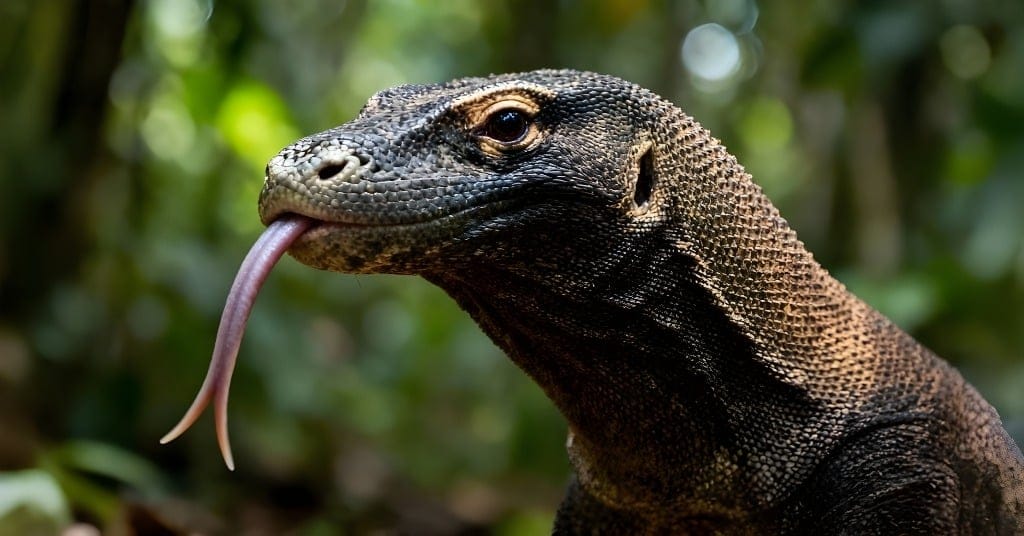The Living Dragon of the Modern World
The Komodo dragon is not a mythical creature from ancient tales—it’s a real, living giant. Found mainly on the Indonesian islands of Komodo, Rinca, Flores, and Gili Motang, this colossal giant lizard is the closest living resemblance to dinosaurs. With its massive size, sharp claws, and venomous bite, the Komodo dragon rules its territory like a true apex predator.
Often featured in nature documentaries and research studies, this prehistoric creature has fascinated scientists and travelers alike. From its hunting style to its ancient lineage, the Komodo dragon stands as one of the most awe-inspiring animals on Earth.
Physical Appearance: The Giant Lizard That Rules the Land
A fully grown Komodo dragon can reach up to 10 feet (3 meters) in length and weigh over 150 pounds. Its muscular body, scaly skin, and long tail lend it a powerful presence. The creature’s skin is reinforced with tiny bones called osteoderms, acting like natural armor.
Its forked tongue flicks constantly, detecting scent particles in the air—an evolutionary advantage that helps it locate prey miles away. The Komodo dragon is a cold-blooded reptile that does well in the hot, tropical weather of the Indonesian islands. It fits in perfectly with its rocky, dry habitat.
Behavior and Intelligence: More Than Just a Predator
Unlike most reptiles, the Komodo dragon exhibits remarkable intelligence. Studies indicate that they recognize their keepers, learn feeding routines, and even display signs of curiosity. Their reptile behavior isn’t just instinctive—it shows adaptability and awareness, traits rarely seen in cold-blooded species.
In the animal kingdom, intelligence often correlates with hunting efficiency. The Komodo dragon’s hunting techniques prove this. It stalks its prey silently, waiting for the perfect moment to strike. A single bite injects venom that prevents blood from clotting, causing the victim to weaken gradually.
Diet and Hunting: Masters of the Slow Kill
The Komodo dragon is a carnivore with a diet that includes deer, pigs, birds, and occasionally smaller lizards, such as other Komodo dragons. Using stealth and patience, it ambushes its prey. A single venomous bite from this predator is enough to cause shock, blood loss, and eventual collapse.
What’s fascinating is how these reptiles follow their dying prey for hours—or even days—using their keen sense of smell. Once the animal succumbs, the dragon consumes nearly everything, bones included. This brutal yet efficient process plays a crucial role in maintaining the balance of ecosystems.
Reproduction and Life Cycle: Born to Survive
During the breeding season, male dragons engage in wrestling matches, standing on their hind legs to overpower rivals. Females lay about 15–30 eggs, which hatch after eight months. Immediately, the hatchlings climb trees to evade adult predators, demonstrating their strong survival instincts.
Young dragons live arboreally for several years, feeding on insects and small vertebrates. As they grow, they descend to the ground, ready to claim their place in the harsh world of natural habitat competition.
Habitat and Range: The Treasures of Komodo National Park
The Komodo dragon’s home is the Komodo National Park, a UNESCO World Heritage Site established in 1980 to protect these creatures and their fragile ecosystem. The park encompasses volcanic landscapes, dry savannahs, and coastal mangroves—perfect environments for these reptiles to thrive.
However, habitat loss and human interference have threatened their population. Conservationists and local authorities have implemented stringent laws to protect them, with a focus on wildlife conservation and sustainable tourism. Visitors can explore the park safely with trained guides, ensuring both education and protection.
Venom and Myth: Science Meets the Dragon Legend
For centuries, local folklore described the Komodo dragon as a mystical beast capable of breathing fire. While that’s pure legend, science has uncovered equally astonishing truths. The venomous bite of the dragon delivers toxins that lower blood pressure and cause shock, proving that reality often surpasses fiction.
Its fearsome reputation inspired countless dragon legends, cementing its place in Indonesia’s cultural identity. From ancient myths to modern wildlife photography, the Komodo dragon remains a symbol of raw power and mystery.
Conservation Efforts: Protecting the Endangered Species
Despite its dominance, the Komodo dragon faces grave threats. Classified as an endangered species by the IUCN, fewer than 3,000 individuals remain in the wild. Poaching, habitat loss, and climate change are the main culprits.
Organizations and governments work tirelessly to ensure their survival through breeding programs, habitat restoration, and community education. Wildlife conservation groups collaborate globally, ensuring that this ancient prehistoric creature remains inspirational for future generations.
Komodo Dragon in Modern Media and Tourism
The Komodo dragon has become a cultural icon. Featured in documentaries by National Geographic and BBC Earth, it has drawn global attention. Adventure seekers travel from all over the world to Indonesia to witness these dragons in their natural setting.
For photographers, wildlife photography in the Komodo Islands offers breathtaking opportunities to capture these giants. Responsible tourism plays a big part in raising awareness and funding for conservation projects.
Why the Komodo Dragon Matters
Every apex predator serves a vital purpose. The Komodo dragon helps regulate prey populations, supporting biodiversity and maintaining ecological harmony. Its existence is a living reminder of evolution’s power and nature’s resilience. By understanding and protecting these creatures, humans ensure the stability of the ecosystem balance. The world would lose more than a species—it would lose a living link to Earth’s ancient past.
Conclusion: The Last Dragon on Earth
The Komodo dragon stands as a testament to survival, evolution, and the grandeur of nature. From the volcanic soils of the Indonesian islands to global conservation efforts, it commands both respect and awe. Its story is one of strength, adaptability, and ancient legacy. Protecting it isn’t just about saving a species—it’s about preserving a living chapter of our planet’s history.

